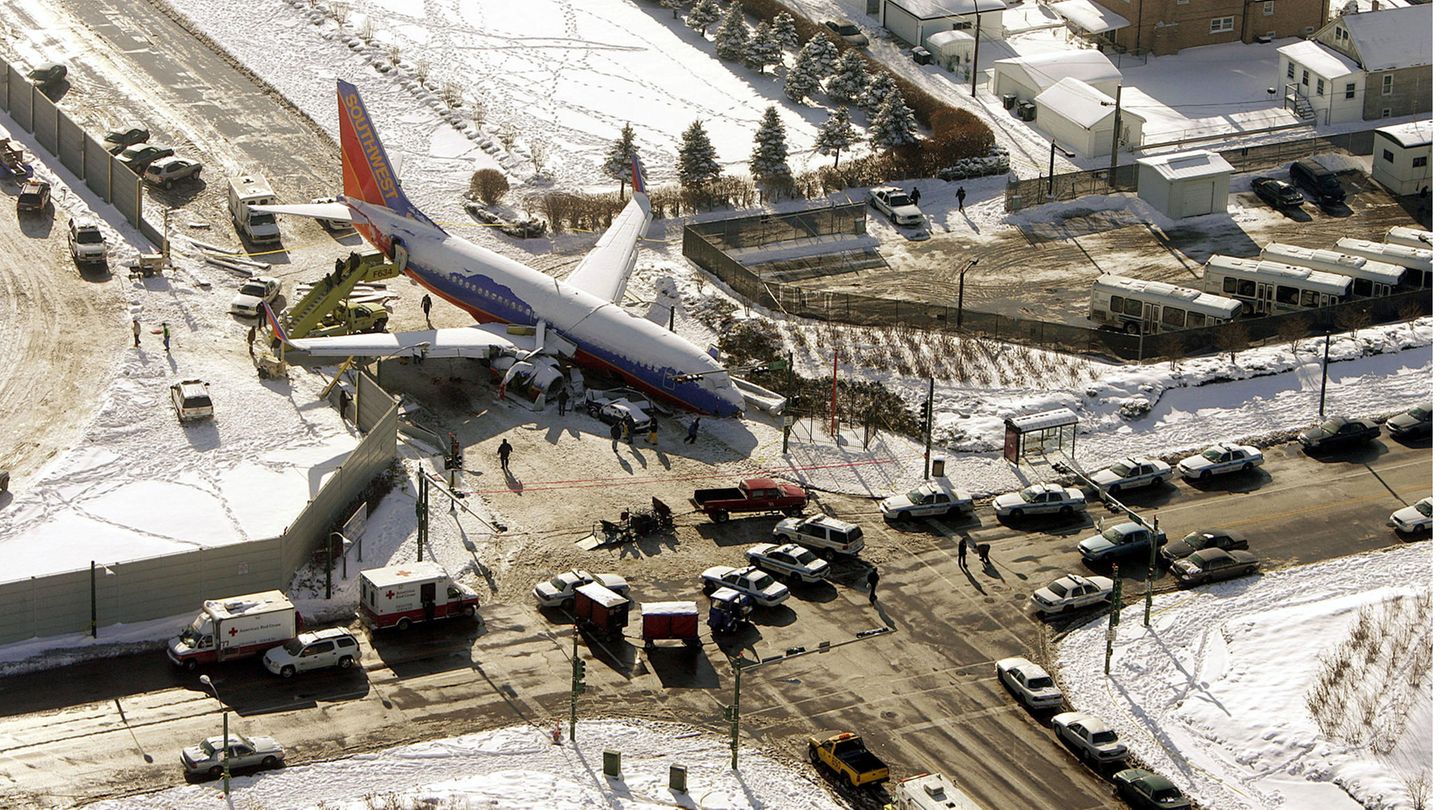
On the freezing evening of December 8, 2005, Southwest Airlines Flight 1248 approached Chicago Midway Airport under a blanket of heavy snow, biting winds, and treacherous runway conditions. What should have been a routine landing turned into a catastrophic chain of events, driven by fatigue, miscommunication, poor planning, and one forgotten step that would cost a child’s life and expose alarming gaps in aviation safety protocols.
The Boeing 737-700 carrying 103 passengers and five crew had taken off hours earlier from Baltimore following a nearly two-hour ground delay. Onboard were two highly experienced pilots: a 59-year-old captain with 15,000 hours of total flight time and a 34-year-old first officer with 8,500 hours. But despite their extensive backgrounds, they were about to make a fatal mistake in one of the most challenging landing scenarios imaginable.
From the beginning, the odds were stacked against them. Weather forecasts warned of intense snowfall in the Chicago area, with visibility falling below 800 meters and freezing fog creeping over the runways.
The pilots, cautious but determined, took the necessary preemptive steps: they loaded up with extra fuel, selected two alternate airports in case they needed to divert, and reviewed every detail of their landing procedures. One key decision was whether to use a system they had never deployed in landing before—the auto-brake feature of the 737-700.
Although the system had existed on the aircraft for years, Southwest Airlines had not implemented its use during landings because their older 737 models did not include it. But now that the fleet was being modernized, its use was becoming standard. The pilots believed—mistakenly—that this flight would be their first under the new procedure. In reality, the implementation had been delayed again, but the crew never received that update.

Complicating matters further was the state of Midway Airport. The compact airport, surrounded by dense housing and crisscrossed by major highways, lacked the standard runway safety buffers. The runway the pilots were cleared to land on—Runway 31C—had only 82 feet of safety area instead of the required 1,000. Though plans were underway to install an arrestor bed made of collapsible concrete, nothing had yet been implemented. Still, the crew forged ahead.
Their weather data indicated braking action on the runway was “fair” in the first half and “poor” in the second. Southwest’s rules stated that if any part of the runway was rated “poor,” the aircraft was limited to a maximum tailwind of five knots. But the pilots misread the situation.
Believing that the split report allowed for a ten-knot tailwind, they accepted landing with eight knots of tailwind—a critical error that would ripple through every decision afterward.
To calculate whether they could stop safely, the pilots used the onboard performance computer (OPC), but the device had a flaw. While they entered an eight-knot tailwind, the computer automatically corrected this to five knots due to poor braking action but did so silently, without notifying the crew. As a result, their landing performance calculations were overly optimistic, assuming a lighter tailwind than reality.
More dangerously, the captain mistakenly believed that reverse thrust—the ability to redirect engine power backward to help stop the plane—was not factored into the performance figures. He assumed that using full reverse thrust would give them additional margin. However, in the newer 737-700, reverse thrust was included in the calculations. There was no hidden safety buffer. The numbers were already as tight as they could be.
As they descended into Chicago, the crew entered a holding pattern due to snow clearing operations on the runway. The latest runway condition reports showed no improvement. Nevertheless, the crew, reassured by their flawed calculations and misunderstanding of procedures, decided to proceed. The captain confirmed he would try the auto-brake system but would intervene with manual braking if needed.

As the plane broke through the cloud cover and aligned with the ILS glide path, everything appeared nominal. The aircraft was stable, properly configured, and touched down firmly within the designated touchdown zone at 1912:28 local time, traveling 124 knots.
That’s when everything began to unravel. The captain deployed the thrust reversers—but failed to move them into full reverse. Distracted by monitoring the auto-brake system for its unfamiliar behavior, he did not notice that the reversers were only partially deployed.
He then turned his full attention to braking, which felt disturbingly ineffective. Both pilots reported a sensation that the aircraft was accelerating, though it was likely the result of very low deceleration. The slippery runway meant the anti-skid system was releasing brake pressure repeatedly, preventing the wheels from locking but also diminishing braking efficiency. Still, with the thrust reversers essentially inactive, they had lost a major stopping force.
Eighteen seconds passed. The aircraft was now over halfway down the runway and had barely slowed. It was the first officer who noticed the reversers were not fully engaged. In a desperate move, he reached over, pushed the captain’s hand aside, and slammed the thrust levers into full reverse. But it was far too late.
At 53 knots, the aircraft overran the end of the runway, crashing through the inadequate safety area, tearing through a blast fence and a navigational antenna, and barreling across an airport service road. Moments later, it breached the perimeter fence and burst onto a busy highway. There, it struck a northbound car carrying a family. Inside was a six-year-old boy, who was killed instantly. One adult was severely injured. It was a tragedy born from seconds of confusion, errors, and oversight.

All passengers and crew onboard the aircraft survived, and the emergency evacuation was conducted without further incident. But the aftermath was damning. Investigators found multiple layers of human and systemic failure. The pilots should never have attempted the approach with a reported tailwind of eight knots and poor braking action.
The misunderstanding about the thrust reversers’ role in the landing calculation reflected a broader training gap across the airline. Many Southwest pilots interviewed after the accident shared the same incorrect assumptions. Worse still, at the time, the FAA did not mandate that airlines perform updated landing performance assessments during flight—only before departure. Each airline had its own method or none at all. This lack of standardization meant critical discrepancies in safety.
In response, the FAA moved quickly. New recommendations required inflight landing performance calculations using current weather and runway data before every landing. A 15% safety buffer was mandated for added protection. Chicago Midway was also ordered to expedite the installation of an EMAS (Engineered Materials Arresting System) at runway ends, which could have prevented the aircraft from ever reaching the highway.
But none of those actions could undo what had happened that night. A child’s life had been lost because two skilled pilots were overwhelmed by a combination of bad weather, new technology, ambiguous procedures, and an airport not built to accommodate mistakes. The crash of Flight 1248 remains a stark reminder that even the smallest oversights in aviation can lead to devastating consequences.
It is a case study in why redundancy, clarity, and humility are vital in high-risk environments. The aircraft touched down on target, but the human element—misinterpretation, distraction, and assumption—took it straight into disaster. This was not a failure of machines. It was a failure of understanding. And it is one that the aviation industry will never forget.



